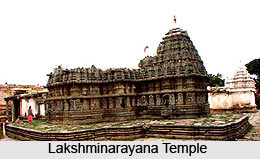 Lakshminarayana Temple was built by Vira Someshwara of the Hoysala Empire in 1250 CE. The temple is an example of a trikuta vimana with only the central shrine exhibiting a tower on top. The lateral shrines are square with five projections. The central shrine is decorated and its tower has a sukanasi which is the tower of the vestibule. This vestibule connects the shrine to the hall. The temple is made of soapstone. The temple is built on a platform, a Hoysala innovation that elevates the entire temple by about a metre.
Lakshminarayana Temple was built by Vira Someshwara of the Hoysala Empire in 1250 CE. The temple is an example of a trikuta vimana with only the central shrine exhibiting a tower on top. The lateral shrines are square with five projections. The central shrine is decorated and its tower has a sukanasi which is the tower of the vestibule. This vestibule connects the shrine to the hall. The temple is made of soapstone. The temple is built on a platform, a Hoysala innovation that elevates the entire temple by about a metre.
The temple belongs to the 2nd phase of Hoysala building activity as it has two sets of eaves. In between two eaves there are decorative miniature towers on pilasters, with sculptured wall images of Hindu deities below the second eave. It is a Vaishnava temple, as most of the images represent some form of Lord Vishnu, his consort and his attendants. There are there are 120 such images. There are totally 24 sculptures of Vishnu standing upright holding in his four arms the four attributes. Below the panel there is the base of the wall consisting of six decorative rectangular mouldings of equal width which run around the temple.
The six horizontal mouldings are sculptured known as friezes. The first frieze depicts birds, the second depicts aquatic monsters, the third frieze has depictions of Hindu epics and stories from Indian puranas, the fourth frieze has leafy scrolls, the fifth and sixth friezes have a procession of horses and elephants. The temple interior consists of a closed hall of with four beautiful lathe turned pillars that are supporting the roof. The four central pillars are divided into nine equal bays and decorated ceilings. The sanctum of three shrines contain images of Venugopala, Narayana in the middle and Lakshminarasimha; and other forms of Vishnu
This article is a stub. You can enrich by adding more information to it. Send your Write Up to content@indianetzone.com





















